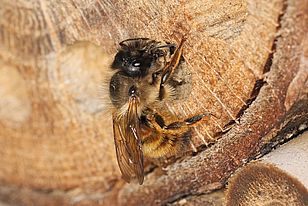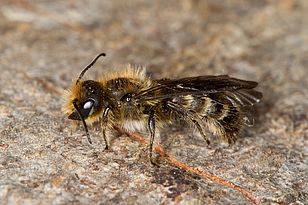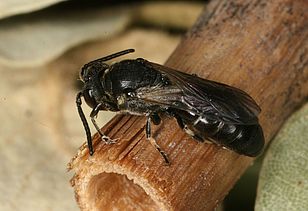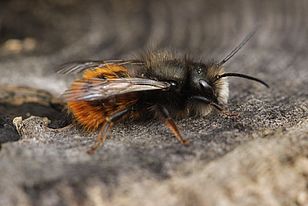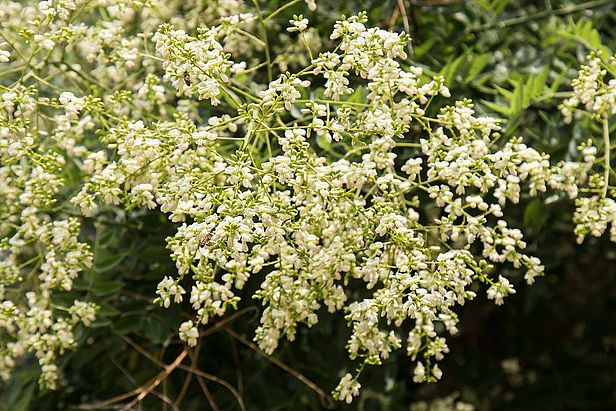Publications
10.11.2021 | Joan Casanelles Abella, ed. by Stephanie Kusma | News WSL
A new study shows which plants are crucial for the survival of bee larvae and how this influences the distribution of wild bees in cities. The results provide valid information for the protection of wild bees in urban areas.
Wild bees and their larvae depend on pollen and nectar resources to survive. Some species show a distinct food preference and only collect pollen from a handful of plant species. Others, so-called generalists, use many plant species. Cities can be “hotspots” for plants as they host a broad mixture of native and exotic species as well as cultivated varieties. Therefore, the question arises: Do bees benefit from these unique urban plant communities?
An international team involving seven countries and lead by Marco Moretti and Joan Casanelles Abella from the Swiss Federal Institute for Forest, Snow and Landscape Research WSL has been investigating this topic. To do this, they examined four solitary bee species in more detail. All of them build their nests in caves, such as bee hotels, and are found in cities: European orchard bee (Osmia cornuta), Red mason bee (Osmia bicornis), Sleepy scissor bee (Chelostoma florisomne) and the Common yellow faced bee (Hylaeus communis).
The studied wild bee species. From top to bottom, left to right: Red mason bee (Osmia bicornis), Sleepy scissor bee (Chelostoma florisomne), Common yellow-faced bee (Hylaeus communis), Photos: Beat Wermelinger, WSL. European orchard bee (Osmia cornuta), Photo: Björn S., CC BY-SA 2.0 (via Wikimedia Commons).
For their study, the researches set up bee hotels in a total of 80 public green spaces in five different cities – Antwerp, Paris, Poznan, Tartu and Zurich. After the summer season, they collected the bee hotels and “hibernated” them in the laboratory. With the aid of genetic analyses, they then determined which plant species the pollen remains in the nests originated from.
Different strategies to thrive in cities
Previous studies have shown that urbanization tends to promote generalist species. In this study, the Common yellow-faced bee was the most generalist species and also the most widespread. This bee used pollen from a total of 81 plant species from 31 families for its larvae. However, this strategy is costly, because many pollen types are rather difficult to digest or even toxic. In fact, the study showed that also other strategies than broad generalism can be successful in cities.
The European orchard bee and the Red mason bee, for example, visited a large number of plant species (33 and 51 respectively), but the vast majority of the pollen collected from their nests came from only a few plant families. Both species preferred shrubs and trees. The European orchard bee mainly used willow, apple and maple, whereas the Red mason bee used beech, oak and walnut.
Popular with people and bees
This suggests that preference for certain plant families may be an advantage for bees in cities if these plants are abundant. Moreover, these bees can switch from species to species within a given plant family and thus use the available resources more efficiently.
Still, even strict specialists can be successful in cities if their preferred plant is widely distributed. This is the case for the Sleepy scissor bee, which feeds on various species of buttercups (Ranunculus spp.), that grow abundantly in cities.
Urban trees for urban bees
“Surprisingly, typical urban plants such as dandelions and clover contributed little or nothing to the larval diet of our studied bee species”, says Joan Casanelles Abella from WSL, lead author of the study. Woody species, on the other hand, proved to be a frequently used resource. For example, the Common yellow-faced bee increasingly collected pollen from trees, especially from the Japanese pagoda tree (Styphnolobium japonicum), with decreasing amounts of green space. “This shows that maintaining a diverse vegetation, especially of trees and shrubs, is crucial to ensure the nutrition of the larvae of our wild bee species.” Trees and shrubs may also be important for other urban wild bee species, especially those that appear early in the season. As the distribution of trees in cities is largely influenced by humans, this provides an important starting point for greening strategies, especially in densely populated urban areas where few herbaceous plants grow. More trees would also allow wild bees to populate new areas and facilitate foraging.
Exotic or native?
Whether the plants are native or exotic seems to have little influence on the preference of wild bees. More important are characteristics such as the nutrient content of the pollen, the morphology of the flowers or the blooming time, which can be relatively constant within a plant family. Wild bees with an intermediate form of generalism could therefore benefit from exotic woody plants: If those tree species belong to their preferred plant families and grow in addition to native ones, the species complement each other as food resources. “To promote at least part of our wild bee species, diverse urban forests should be promoted in urban green space“, Casanelles Abella states.
Contact
Copyright
WSL and SLF provide the artwork for imaging of press articles relating to this media release for free. Transferring and saving the images in image databases and saving of images by third parties is not allowed.


